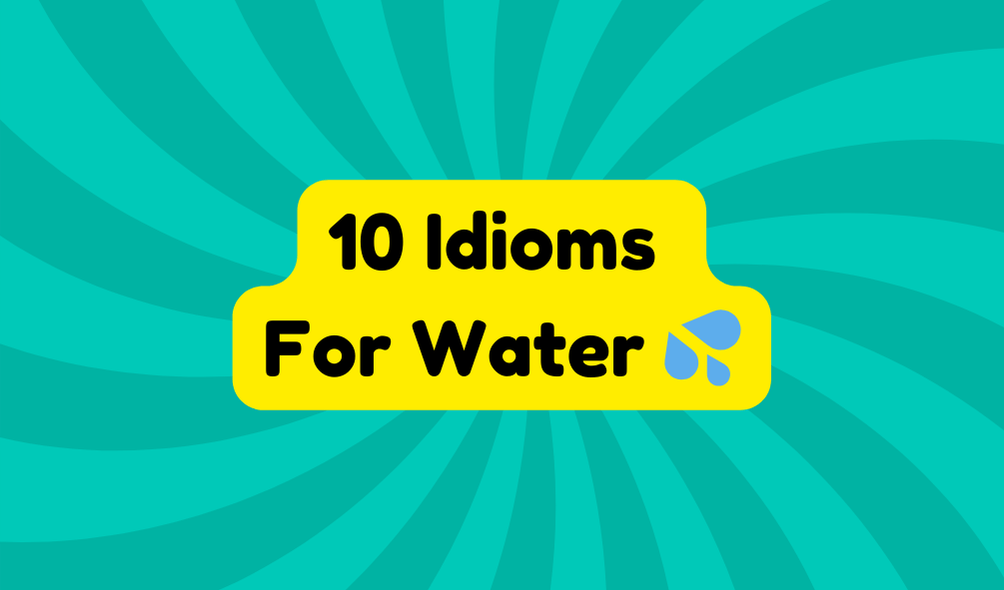Water—essential, powerful, and ever-changing—has shaped human civilization since our earliest days. From mighty oceans to gentle streams, water bodies have provided sustenance, transportation, and inspiration across cultures. It’s no surprise that water has seeped deeply into our language, creating a reservoir of expressions that reflect its various forms and behaviors. This collection explores ten vivid idioms that harness water’s symbolic power to express complex human experiences and situations.
1. Testing the Waters
Short meaning: Trying something cautiously before fully committing.
We’ve all faced situations where diving headfirst seems risky—a new relationship, career change, or unfamiliar skill. The idiom “testing the waters” perfectly captures those tentative first steps, describing the careful way we sometimes ease into new experiences.
The expression comes from the literal act of checking water temperature before immersion. Imagine standing at a lake’s edge on a spring morning, dipping in just your toes before deciding whether to swim. That small, exploratory action reveals crucial information without the commitment or risk of full immersion. The idiom transfers this physical caution to various life circumstances where gradual engagement proves wiser than immediate plunging.
We see this approach in countless situations. The businessperson who launches a small pilot project before investing millions. The musician who shares compositions with trusted friends before public performance. The person contemplating divorce who first suggests a trial separation. Each exemplifies testing the waters—gathering information through limited exposure before making bigger decisions.
What makes this idiom particularly useful is its acknowledgment of both curiosity and caution. Testing the waters isn’t about fear or avoidance—it’s about smart exploration. It recognizes our natural desire to experience new things while respecting potential consequences of hasty commitment.
Consider how differently things might unfold without this approach. The entrepreneur who invests their life savings without market research. The college student who declares a major without taking introductory courses. The person who moves across country for a relationship after just one weekend together. These scenarios often lead to painful lessons about impulsivity.
The wisdom of testing the waters resonates across cultures because water itself presents universal challenges. Whether faced with mountain streams or tropical seas, humans have always needed to assess water conditions before trusting their safety to its depths. This shared experience makes the metaphor immediately understandable across diverse backgrounds.
2. Like Water Off a Duck’s Back
Short meaning: Criticism or trouble that has no lasting effect, easily shrugged off without impact.
Resilience takes many forms, but perhaps none is depicted more elegantly than in the idiom “like water off a duck’s back.” This expression describes criticism or difficulties that simply slide away without causing harm, just as water droplets roll off a duck’s waterproof feathers without penetrating.
The idiom draws from direct observation of nature. Duck feathers contain remarkable natural waterproofing—a combination of special oils and intricate feather structure that prevents water absorption. When rain falls on a duck, the droplets form perfect beads that roll away immediately, leaving the duck dry and unaffected beneath. This natural phenomenon provides the perfect metaphor for emotional resilience.
We apply this expression to describe how certain individuals seem naturally protected against criticism or setbacks. The confident professional who remains unfazed by a colleague’s harsh feedback. The artist who continues creating despite negative reviews. The politician who maintains composure through public criticism. Each demonstrates the quality of letting negative experiences slide away without absorption.
What makes this idiom particularly powerful is the image of continued functioning despite external conditions. The duck doesn’t hide from rain or become incapacitated by it—it continues swimming, flying, and living normally while water simply slides away. Similarly, resilient people don’t avoid challenges but instead develop properties that prevent those challenges from penetrating their essential wellbeing.
This quality differs significantly from ignoring valid criticism or denying reality. True duck-back resilience involves conscious processing—registering the experience but choosing what deserves internalization. The duck’s feathers touch the water but selectively prevent harmful absorption. Emotionally resilient people similarly differentiate between constructive feedback worth absorbing and harmful criticism better let go.
The idiom reminds us that resilience often comes from natural properties developed over time rather than conscious effort in each moment. The duck doesn’t actively repel each raindrop—its well-maintained feathers handle this automatically. Similarly, emotional resilience becomes most effective when cultivated as an ongoing property rather than an emergency response.
3. In Deep Water
Short meaning: Being in serious trouble or a difficult situation beyond one’s experience or capability.
Few situations generate more immediate anxiety than finding yourself beyond your depth in water. That visceral fear—realizing solid ground has disappeared beneath your feet while water surrounds you—provides powerful metaphorical language for life’s overwhelming challenges. The idiom “in deep water” captures this frightening loss of control when facing difficulties beyond our current capabilities.
Unlike shallow waters where we maintain firm footing, deep water removes our stability and control. The expression likely originated from literal observations of swimming mishaps, where the transition from confident wading to desperate treading marks a dangerous boundary. This physical experience translates perfectly to various life situations where we suddenly find ourselves overwhelmed and struggling to stay afloat.
We use this idiom to describe numerous challenging circumstances. The small business owner facing unexpected financial crisis finds herself in deep water. The student tackled advanced classes without prerequisite knowledge experiences this drowning sensation. The person who tells increasing lies until discovery becomes inevitable knows this sinking feeling. Each situation shares common elements: challenges exceeding current capabilities, loss of stable reference points, and urgent need for adaptation or assistance.
What makes this expression particularly effective is how it captures both the situational difficulty and the emotional experience simultaneously. Being in deep water describes both objective circumstances and subjective feelings—the actual challenge and the accompanying sensation of being overwhelmed. The idiom communicates not just “I face difficulties” but more specifically “I face difficulties exceeding my current capabilities.”
Deep water situations often arrive through gradual progression rather than sudden plunge. The wader feels increasingly buoyant before realizing the bottom has disappeared. Similarly, many overwhelming situations develop incrementally—debt accumulates gradually, relationship problems compound slowly, academic challenges build over time. This pattern makes deep water particularly dangerous, as we often don’t recognize the critical transition until already struggling.
The idiom carries implicit warning about preparation and humility. Skilled swimmers rarely fear deep water because they’ve developed capabilities matching the environment. Similarly, appropriate preparation through education, mentorship, and gradual challenge helps prevent finding ourselves desperately struggling beyond our depth in life’s various domains.
4. Make Waves
Short meaning: To cause trouble, create a disturbance, or challenge the status quo.
In calm waters, a boat can pass almost unnoticed, leaving minimal disturbance in its wake. But some vessels—through speed, size, or deliberate action—create significant ripples that affect everything nearby. The idiom “make waves” captures this disruptive impact, describing people whose actions disturb established patterns and comfortable equilibrium.
The expression draws from practical maritime experience, where wave creation affects other vessels and shorelines. Small boats producing large wakes near docks or in narrow channels can damage property and disturb others—a physical disruption with meaningful consequences. This concrete image transfers perfectly to social situations where individuals disrupt established norms or comfortable routines.
We apply this idiom across various contexts. The new employee questioning inefficient processes is making waves. The community member challenging discriminatory practices creates this ripple effect. The family member addressing long-ignored dysfunction produces similar disturbance. Each disrupts established patterns, creating effects that spread beyond their immediate actions.
What distinguishes this expression is its ambiguity—making waves can be either positive or negative depending on perspective and circumstances. From one viewpoint, wave-makers create unnecessary trouble; from another, they drive essential change. The boat owner annoyed by rocky waters might condemn the wave-maker, while those benefiting from subsequent improvements might celebrate the same disruption.
This dual nature makes the idiom particularly rich. It acknowledges that meaningful change rarely occurs without disturbing something. Organizations don’t improve without questioning current methods. Social justice doesn’t advance without challenging established norms. Relationships don’t heal without disrupting unhealthy patterns. Positive transformation typically requires some waves.
The idiom also captures how disturbances propagate beyond their source. Just as water waves travel outward affecting distant shores, social disruptions spread through communities and institutions. The employee questioning ethics might initially create small ripples that eventually transform company culture. The citizen challenging unjust laws might generate waves that eventually reshape society itself.
5. Water Under the Bridge
Short meaning: Past events or problems that are no longer important or relevant to current situations.
Rivers flow continuously, carrying water that passes beneath bridges and continues downstream, never to return. This natural flow provides the perfect metaphor for how time moves forward, carrying away moments that—once passed—cannot be recaptured. The idiom “water under the bridge” harnesses this image to describe past events we choose to leave behind, recognizing their irretrievable nature.
The expression likely emerged from direct observation of flowing water. Standing on a bridge, one watches water pass beneath and disappear downstream—a perfect visual representation of time’s passage. This physical reality transforms into metaphorical language for psychological release, describing how we might similarly let certain experiences flow away rather than attempting to hold them back.
We use this idiom when deliberately choosing to move beyond past difficulties. Former business partners might declare their previous disagreements “water under the bridge” when beginning new collaboration. Long-separated friends could use this phrase when reconciling without dwelling on old grievances. Family members might apply it to past hurts when seeking healthier relationships. Each usage acknowledges both the reality of past events and the decision not to let them determine future interactions.
What gives this expression particular power is its recognition of both acknowledgment and release. Water under the bridge doesn’t deny that water flowed—it simply recognizes that flow has moved downstream. Similarly, using this idiom doesn’t deny past experiences but acknowledges their placement in history rather than present reality.
This approach differs significantly from suppression or denial. Declaring something “water under the bridge” typically follows processing rather than avoiding difficult emotions. The expression doesn’t suggest forgetting but rather conscious repositioning—recognizing past events as part of history rather than active concerns demanding current attention.
The idiom also contains implicit wisdom about natural processes. Just as fighting against water’s downstream flow proves futile, resisting time’s forward movement often wastes energy better directed elsewhere. Some events, once passed, cannot be changed regardless of how much mental energy we invest in replaying them. Recognizing certain experiences as water under the bridge allows redirection toward present circumstances where our actions still matter.
6. A Drop in the Bucket
Short meaning: A very small amount that seems insignificant compared to what is needed or expected.
Some contributions seem almost negligible against enormous needs—like adding a single water droplet to a bucket that requires filling. The idiom “a drop in the bucket” captures this stark disproportion, describing efforts that, while real, appear almost meaningless against the scale of challenges they address.
The expression has biblical origins, appearing in Isaiah 40:15 where nations are described as “a drop in a bucket” compared to God’s greatness. This ancient image has persisted because it so effectively captures the humbling experience of measuring limited resources against vast requirements. The physical image—one water drop against an empty bucket’s volume—provides immediate, intuitive understanding of overwhelming disproportion.
We apply this idiom to various situations involving scale disparities. A small donation to massive humanitarian crisis might feel like a drop in the bucket. Minor policy changes addressing climate change can seem equally insufficient. Individual actions against systemic problems often appear this way. Each example involves genuine contribution that nonetheless appears almost irrelevant against the challenge’s magnitude.
What makes this expression particularly complex is its potential interpretation as either discouragement or realistic perspective. Viewed negatively, the idiom might justify inaction—”Why bother contributing when my effort is just a drop in the bucket?” Viewed constructively, it simply acknowledges scale without dismissing value—”My contribution is just a drop in the bucket, but buckets fill through accumulated drops.”
This dual nature makes the expression useful for both cautioning against overstating impact and encouraging persistence despite limited individual effect. The billionaire claiming significant impact on global poverty through modest donations might need reminding they’ve added mere drops to an enormous bucket. Conversely, the individual feeling their environmental efforts don’t matter might need reminding that oceans themselves form from accumulated drops.
The idiom also subtly acknowledges the collective nature of addressing large challenges. A single drop accomplishes little, but countless drops eventually fill any bucket. This understanding underpins many social movements and cooperative efforts, where individual contributions gain significance through accumulation rather than individual impact.
7. Keep Your Head Above Water
Short meaning: Managing to survive or stay afloat amid difficulties, particularly financial pressures.
Survival in water requires keeping your airway clear—allowing breathing to continue despite surrounding liquid. This essential requirement provides powerful metaphorical language for life’s various struggles. The idiom “keep your head above water” captures the fundamental effort to maintain basic functioning during overwhelming challenges, particularly financial ones.
The expression draws from the literal experience of swimming or treading water, where keeping one’s head above the surface represents the minimum requirement for survival. This physical reality translates effectively to various life situations where people struggle to meet basic needs while surrounded by difficulties.
We use this idiom primarily for financial challenges, though it extends to other survival contexts. The family living paycheck-to-paycheck is keeping their head above water. The small business covering costs without generating profit experiences this state. The student balancing full-time work with academic responsibilities knows this struggle. Each involves meeting minimum survival requirements without achieving comfort or progress.
What distinguishes this expression is its focus on basic survival rather than thriving. Keeping your head above water doesn’t mean swimming powerfully or reaching distant shores—it simply means not drowning. The idiom acknowledges situations where success means merely continuing rather than advancing, where survival itself represents achievement.
This reality characterizes many life phases. Economic downturns, health crises, caregiving responsibilities, and educational challenges can all create periods where simply continuing deserves recognition. The idiom provides language that acknowledges both the struggle and the accomplishment of persistence during difficulty.
The expression also captures the exhausting nature of such periods. Treading water consumes significant energy while producing no forward movement—an apt metaphor for situations requiring immense effort just to maintain position. The single parent working multiple jobs to provide necessities. The chronically ill person completing basic daily tasks. The overextended caregiver meeting others’ needs while neglecting their own. Each experiences the exhaustion of constant effort that barely maintains position.
8. Blood is Thicker Than Water
Short meaning: Family relationships are stronger and more important than other types of relationships.
Few idioms generate more debate about original meaning than “blood is thicker than water.” In its common modern usage, this expression asserts that family ties naturally exceed other relationships in strength and importance—that genetic connections inherently outweigh chosen associations.
The idiom appears in its current form in 18th century writings, though similar expressions existed earlier across multiple cultures. Its endurance reflects ongoing cultural negotiation around family obligations versus other relationships. The physical observation—that blood has greater viscosity than water—provides concrete imagery for abstract social bonds of varying strengths.
We encounter this expression most often when navigating conflicts between family and non-family priorities. Parents might remind children that “blood is thicker than water” when encouraging support of siblings despite disagreements. Extended families invoke this principle when expecting attendance at gatherings despite distance or inconvenience. The idiom frequently appears when family expectations conflict with romantic relationships, friendships, or career obligations.
What makes this expression particularly interesting is ongoing debate about its original form. Some scholars suggest the complete proverb was “the blood of the covenant is thicker than the water of the womb”—essentially reversing the modern meaning to suggest that chosen bonds (covenant blood) prove stronger than biological accident (womb water). While this alternative interpretation lacks definitive historical evidence, the debate itself reflects genuine tension between obligations to birth family versus chosen connections.
This tension permeates many life decisions. The adult choosing between holiday traditions with family of origin versus romantic partner. The individual navigating differently between family expectations and personal aspirations. The person weighing career relocation against proximity to relatives. Each confronts questions about whether biological connections inherently deserve priority over other meaningful relationships.
Cultural differences significantly impact interpretation of this idiom. Some societies emphasize family obligations as primary and non-negotiable, while others increasingly prioritize individual choice in relationship formation. The expression functions differently across these contexts—sometimes reinforcing established norms and sometimes challenging emerging values.
9. Sink or Swim
Short meaning: A situation where one must succeed through their own efforts or fail completely.
Learning sometimes comes through gradual guidance, with careful support preventing serious failure. Other times, necessity forces rapid adaptation without safety nets—situations where survival depends entirely on personal capacity to adapt immediately. The idiom “sink or swim” captures these latter circumstances, describing situations where only two outcomes exist: independent success or complete failure.
The expression likely originated from brutal swimming lessons where individuals were simply thrown into water without prior instruction. Rather than gradual introduction to swimming skills, this approach created immediate survival pressure—either develop necessary movements quickly or face potential drowning. This harsh method transferred metaphorically to various life situations where similar adaptation pressure exists.
We apply this idiom to numerous challenging circumstances. The new employee given responsibilities without training faces a sink-or-swim situation. The student transitioning to more independent educational environments experiences this pressure. The person suddenly handling adult responsibilities after sheltered upbringing knows this feeling. Each involves abrupt transition from support to self-reliance, with success depending entirely on personal adaptability.
What distinguishes this expression is its binary nature—the absence of middle ground between success and failure. Unlike gradual learning where partial success represents progress, sink-or-swim situations suggest completeness in either direction. You either develop necessary capacities and succeed (swim) or fail to adapt and experience negative consequences (sink).
This harsh reality characterizes certain life transitions more than others. College freshmen living independently often describe this feeling after leaving structured home environments. First-time parents frequently report similar experiences when bringing newborns home. New immigrants navigating unfamiliar cultural systems commonly face such challenges. These situations share common elements: necessity for rapid adaptation, absence of comprehensive preparation, and significant consequences for failure.
The idiom raises important questions about educational approaches and support systems. While sink-or-swim situations sometimes produce remarkable growth through necessity, they also risk unnecessary failure. Different individuals require different balances between supportive guidance and independent challenge—making blanket application of sink-or-swim approaches potentially harmful to those requiring more structured development paths.
10. Still Waters Run Deep
Short meaning: Quiet or reserved people often have profound thoughts, feelings, or knowledge.
Surface appearances can deceive. A placid lake surface might conceal significant depth and powerful currents beneath—just as quiet individuals often harbor complex thoughts and deep emotions behind calm exteriors. The idiom “still waters run deep” captures this disconnect between outward quietude and inner complexity, cautioning against equating verbal expression with intellectual or emotional depth.
The expression draws from natural observation. In streams and rivers, shallow sections typically create visible surface disturbance as water flows over obstacles. Deeper sections often appear calmer on the surface while containing stronger currents beneath. This physical reality provides perfect metaphorical language for human personality—suggesting that visible “disturbance” (talkativeness, dramatic expression) might indicate shallowness, while calm exteriors might conceal greater depth.
We apply this idiom to quiet individuals whose occasional contributions reveal unexpected wisdom or insight. The reserved colleague who rarely speaks in meetings but offers profound solutions when they do. The quiet student whose occasional questions demonstrate remarkable understanding. The unassuming friend whose rare emotional disclosures reveal deep inner life. Each exemplifies still waters running deep—external quietude concealing internal richness.
What gives this expression particular value is its counter-cultural nature in environments that reward verbal dominance. Many settings—from classrooms to workplaces to social gatherings—naturally advantage extroverted expression and rapid verbal processing. The idiom reminds us that absence of continuous outward expression doesn’t indicate absence of thought or feeling, just different patterns of processing and communication.
The expression also warns against misinterpreting quietness as emptiness or simplicity. Humans naturally fill information gaps with assumptions, often assuming that what cannot be observed doesn’t exist. “Still waters run deep” challenges this tendency, suggesting that unobservable mental and emotional processes may be more substantial than visible ones—that silence might indicate depth rather than vacancy.
This understanding proves particularly important across cultural and neurological differences. Some cultures value verbal restraint and consider excessive talking improper or immature. Various neurological differences affect verbal processing and social communication patterns. The idiom encourages looking beyond communication style to appreciate substance that might appear through different channels or timelines than expected.
Water’s Enduring Flow Through Language
These ten idioms demonstrate water’s remarkable versatility as a linguistic metaphor. From cautious “testing the waters” to resilient “water off a duck’s back,” liquid-based expressions capture countless human experiences. This versatility stems from water’s fundamental properties—its ability to flow and change shape, to sustain life and cause destruction, to reflect light and obscure depth.
Water’s presence in our language reflects its essential role in human survival. As our planet’s most precious resource, water shapes human settlement patterns, agricultural systems, transportation networks, and cultural practices. Our relationship with water—both its necessity and its dangers—has been so fundamental throughout history that it inevitably became encoded in our communication systems.
The idioms explored here represent just a fraction of water-related expressions across languages and cultures. From “watershed moments” to “watering holes,” from “broken dams” to “smooth sailing,” our languages overflow with aquatic references. Each captures some aspect of our complex relationship with this essential element—acknowledging both its life-giving properties and its destructive capacity.
Water imagery resonates across cultural boundaries precisely because its physical properties transcend linguistic differences. Whether in ancient Mesopotamia, imperial China, or contemporary global society, humans recognize water’s capacity to flow around obstacles, to reflect surfaces while concealing depths, to sustain life when controlled and threaten it when unleashed. These universal qualities make water-based idioms immediately comprehensible across diverse contexts.
As we navigate contemporary challenges, these ancient expressions continue offering wisdom. They remind us to approach new experiences cautiously (testing the waters), to let certain difficulties pass without internalization (like water off a duck’s back), to recognize when challenges exceed our capabilities (in deep water), and to appreciate that quiet exteriors may conceal significant depth (still waters run deep).
Water—in all its forms from gentle rain to crashing waves—continues flowing through our language as it has through countless generations before us, reflecting our enduring connection to this most essential element of life on Earth.







